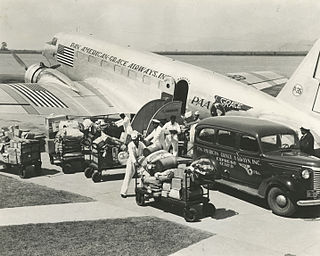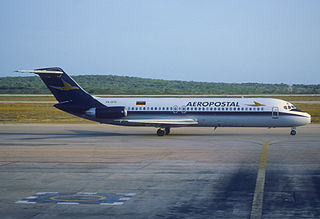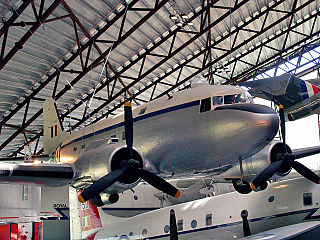
Lloyd Aéreo Boliviano S.A.M., was the flag carrier and principal airline of Bolivia from 1925 until it ceased operations in 2010. Before its demise it was headquartered in Cochabamba and had its main hubs at Jorge Wilstermann International Airport and Viru Viru International Airport. Founded in September 1925, it was the second oldest airline in South America after Avianca and one of the oldest airlines in the world.

On 2 August 1947, Star Dust, a British South American Airways (BSAA) Avro Lancastrian airliner on a flight from Buenos Aires, Argentina, to Santiago, Chile, crashed into Mount Tupungato in the Argentine Andes. An extensive search operation failed to locate the wreckage, despite covering the area of the crash site. The fate of the aircraft and its occupants remained unknown for over fifty years, giving rise to various conspiracy theories about its disappearance.
LATAM Airlines is a Chilean multinational airline based in Santiago and one of the founders of the LATAM Airlines Group, the largest airline holding company in Latin America. Its main hub is Arturo Merino Benítez International Airport in Santiago, with secondary hubs in São Paulo, Lima, Bogotá, Quito, Guayaquil and Asunción.
This is a list of aviation-related events from 1961.
This is a list of aviation-related events from 1977.

Pan American-Grace Airways, also known as Panagra, and dubbed "The World's Friendliest Airline" was an airline formed as a joint venture between Pan American World Airways and Grace Shipping Company. On September 13, 1928, a small single-engine Fairchild airliner flew from Lima, Peru, to Talara, Peru, which marked not only the beginning of Pan American Grace Airways but also the inauguration of scheduled air transportation along the West Coast of South America. From this short flight in 1928 to nonstop flights from New York to South America with Douglas DC-8 Intercontinental Jets in 1966, Panagra became the standard-bearer for transportation between the US Mainland East Coast and the West Coast of South America for 39 years. The "World's Friendliest Airline" merged with Braniff International Airways in 1967, and the combined carrier became the largest US airline serving South America.

On December 16, 1960, a United Airlines Douglas DC-8 bound for Idlewild Airport in New York City collided in midair with a TWA Lockheed L-1049 Super Constellation descending toward LaGuardia Airport. The Constellation crashed on Miller Field in Staten Island and the DC-8 in Park Slope, Brooklyn, killing all 128 aboard the two aircraft and six people on the ground. The accident was the world's deadliest aviation disaster at the time, and remains the deadliest accident in the history of United Airlines.
Transporte Aereo S.A., doing business as LATAM Chile, is a Chilean domestic airline based in Santiago, Chile. It operates few domestic flights for its parent. Its main hub is Arturo Merino Benítez International Airport.

Aero Flight 311, often referred to as the Kvevlax air disaster, was a scheduled domestic passenger flight operated by Aero O/Y between Kronoby and Vaasa in Finland. The aircraft, a Douglas DC-3, crashed in the municipality Kvevlax, nowadays part of Korsholm on 3 January 1961, killing all twenty-five people on board. The disaster remains the deadliest aviation accident in Finnish history. The investigation revealed that both pilots were intoxicated and should not have been flying.

Eastern Air Lines Flight 304, a Douglas DC-8 flying from New Orleans International Airport to Washington Dulles International Airport, crashed on February 25, 1964. All 51 passengers and 7 crew were killed. Among the dead were American singer and actor Kenneth Spencer and Marie-Hélène Lefaucheux, a women's and human rights activist and member of the French delegation to the United Nations.

West Coast Airlines Flight 956 was a scheduled commercial flight in the western United States which crashed on October 1, 1966, approximately 5.5 miles (9 km) south of Wemme, Oregon, southeast of Portland. Thirteen passengers and five crew members were aboard, but none survived. In its first week of service, the aircraft was destroyed by the impact and subsequent fire.

Green Cross was a Chilean sports club that was based in the city of Santiago until 1965, when it moved to Temuco.

LAN-Chile Flight 107 was a regular scheduled international flight from the Chilean capital Santiago to Buenos Aires in Argentina. On 6 February 1965, the Douglas DC-6B-404 operating the flight crashed in the Andes. All 87 occupants of the aircraft died in the crash.

Aeropostal Alas de Venezuela Flight 108 was a short-haul flight from La Chinita International Airport in Maracaibo, Venezuela to Santa Barbara Ed-L Delicias Airport that crashed on March 5, 1991.

The 1961 Derby Aviation crash refers to the fatal crash of a Douglas Dakota IV, registration G-AMSW, operated by Derby Aviation, the forerunner of British Midland Airways, on the mountain of Canigou, France, on 7 October 1961. All 34 on board were killed.

On January 31, 1957, a Douglas DC-7B operated by Douglas Aircraft Company was involved in a mid-air collision with a United States Air Force Northrop F-89 Scorpion and crashed into the schoolyard of Pacoima Junior High School located in Pacoima, a suburban area in the San Fernando Valley of Los Angeles, California.

The 1969 La Paz Lloyd Aéreo Boliviano Douglas DC-6 crash, also known as The Viloco tragedy, was an accident involving a Douglas DC-6B of the Bolivian airline Lloyd Aéreo Boliviano into Mount Choquetanga, 176 km southeast of La Paz, Bolivia, on 26 September 1969, killing all 74 people on board. Including 17 members of a Bolivian association football team named The Strongest.













